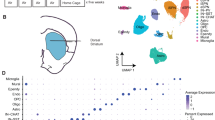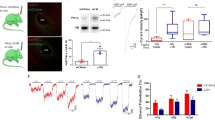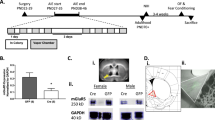Abstract
Adenosine signaling is implicated in several neuropsychiatric disorders, including alcoholism. Among its diverse functions in the brain, adenosine regulates glutamate release and has an essential role in ethanol sensitivity and preference. However, the molecular mechanisms underlying adenosine-mediated glutamate signaling in neuroglial interaction remain elusive. We have previously shown that mice lacking the ethanol-sensitive adenosine transporter, type 1 equilibrative nucleoside transporter (ENT1), drink more ethanol compared with wild-type mice and have elevated striatal glutamate levels. In addition, ENT1 inhibition or knockdown reduces glutamate transporter expression in cultured astrocytes. Here, we examined how adenosine signaling in astrocytes contributes to ethanol drinking. Inhibition or deletion of ENT1 reduced the expression of type 2 excitatory amino-acid transporter (EAAT2) and the astrocyte-specific water channel, aquaporin 4 (AQP4). EAAT2 and AQP4 colocalization was also reduced in the striatum of ENT1 null mice. Ceftriaxone, an antibiotic compound known to increase EAAT2 expression and function, elevated not only EAAT2 but also AQP4 expression in the striatum. Furthermore, ceftriaxone reduced ethanol drinking, suggesting that ENT1-mediated downregulation of EAAT2 and AQP4 expression contributes to excessive ethanol consumption in our mouse model. Overall, our findings indicate that adenosine signaling regulates EAAT2 and astrocytic AQP4 expressions, which control ethanol drinking in mice.
Similar content being viewed by others

Log in or create a free account to read this content
Gain free access to this article, as well as selected content from this journal and more on nature.com
or
References
Abulseoud OA, Miller JD, Wu J, Choi DS, Holschneider DP (2012). Ceftriaxone upregulates the glutamate transporter in medial prefrontal cortex and blocks reinstatement of methamphetamine seeking in a condition place preference paradigm. Brain Res 1456: 14–21.
Alliot F, Pessac B (1984). Astrocytic cell clones derived from established cultures of 8-day postnatal mouse cerebella. Brain Res 306: 283–291.
Brodie C, Kuperstein I, Acs P, Blumberg PM (1998). Differential role of specific PKC isoforms in the proliferation of glial cells and the expression of the astrocytic markers GFAP and glutamine synthetase. Brain Res Mol Brain Res 56: 108–117.
Chen J, Nam HW, Lee MR, Hinton DJ, Choi S, Kim T et al (2010). Altered glutamatergic neurotransmission in the striatum regulates ethanol sensitivity and intake in mice lacking ENT1. Behav Brain Res 208: 636–642.
Choi DS, Cascini MG, Mailliard W, Young H, Paredes P, McMahon T et al (2004). The type 1 equilibrative nucleoside transporter regulates ethanol intoxication and preference. Nat Neurosci 7: 855–861.
Crabbe JC, Belknap JK (1993). Behavior genetic analyses of drug withdrawal. Alcohol Alcohol Suppl 2: 477–482.
Crusio WE, Goldowitz D, Holmes A, Wolfer D (2009). Standards for the publication of mouse mutant studies. Genes Brain Behav 8: 1–4.
Danbolt NC (2001). Glutamate uptake. Prog Neurobiol 65: 1–105.
Dunwiddie TV, Masino SA (2001). The role and regulation of adenosine in the central nervous system. Annu Rev Neurosci 24: 31–55.
Gonzalez-Gonzalez IM, Garcia-Tardon N, Gimenez C, Zafra F (2008). PKC-dependent endocytosis of the GLT1 glutamate transporter depends on ubiquitylation of lysines located in a C-terminal cluster. Glia 56: 963–974.
Gunnarson E, Zelenina M, Axehult G, Song Y, Bondar A, Krieger P et al (2008). Identification of a molecular target for glutamate regulation of astrocyte water permeability. Glia 56: 587–596.
Halassa MM, Fellin T, Haydon PG (2007). The tripartite synapse: roles for gliotransmission in health and disease. Trends Mol Med 13: 54–63.
Hinson SR, McKeon A, Lennon VA (2010). Neurological autoimmunity targeting aquaporin-4. Neuroscience 168: 1009–1018.
Hinson SR, Roemer SF, Lucchinetti CF, Fryer JP, Kryzer TJ, Chamberlain JL et al (2008). Aquaporin-4-binding autoantibodies in patients with neuromyelitis optica impair glutamate transport by down-regulating EAAT2. J Exp Med 205: 2473–2481.
Kalandadze A, Wu Y, Robinson MB (2002). Protein kinase C activation decreases cell surface expression of the GLT-1 subtype of glutamate transporter. Requirement of a carboxyl-terminal domain and partial dependence on serine 486. J Biol Chem 277: 45741–45750.
Kalivas PW (2009). The glutamate homeostasis hypothesis of addiction. Nat Rev Neurosci 10: 561–572.
Katada R, Nishitani Y, Honmou O, Mizuo K, Okazaki S, Tateda K et al (2012). Expression of aquaporin-4 augments cytotoxic brain edema after traumatic brain injury during acute ethanol exposure. Am J Pathol 180: 17–23.
Kim K, Lee SG, Kegelman TP, Su ZZ, Das SK, Dash R et al (2011). Role of excitatory amino acid transporter-2 (EAAT2) and glutamate in neurodegeneration: opportunities for developing novel therapeutics. J Cell Physiol 226: 2484–2493.
Kirschner MA, Copeland NG, Gilbert DJ, Jenkins NA, Amara SG (1994). Mouse excitatory amino acid transporter EAAT2: isolation, characterization, and proximity to neuroexcitability loci on mouse chromosome 2. Genomics 24: 218–224.
Koob GF, Volkow ND (2010). Neurocircuitry of addiction. Neuropsychopharmacology 35: 217–238.
Krystal JH, Petrakis IL, Mason G, Trevisan L, D'Souza DC (2003). N-methyl-D-aspartate glutamate receptors and alcoholism: reward, dependence, treatment, and vulnerability. Pharmacol Ther 99: 79–94.
Lee MR, Hinton DJ, Wu J, Mishra PK, Port JD, Macura SI et al (2011). Acamprosate reduces ethanol drinking behaviors and alters the metabolite profile in mice lacking ENT1. Neurosci Lett 490: 90–95.
Livak KJ, Schmittgen TD (2001). Analysis of relative gene expression data using real-time quantitative PCR and the 2(-Delta Delta C(T)) Method. Methods 25: 402–408.
Lovatt D, Xu Q, Liu W, Takano T, Smith NA, Schnermann J et al (2012). Neuronal adenosine release, and not astrocytic ATP release, mediates feedback inhibition of excitatory activity. Proc Natl Acad Sci USA 109: 6265–6270.
Miguel-Hidalgo JJ (2009). The role of glial cells in drug abuse. Curr Drug Abuse Rev 2: 76–82.
Miguel-Hidalgo JJ, Wei J, Andrew M, Overholser JC, Jurjus G, Stockmeier CA et al (2002). Glia pathology in the prefrontal cortex in alcohol dependence with and without depressive symptoms. Biol Psychiatry 52: 1121–1133.
Naassila M, Ledent C, Daoust M (2002). Low ethanol sensitivity and increased ethanol consumption in mice lacking adenosine A2A receptors. J Neurosci 22: 10487–10493.
Nam HW, Lee MR, Hinton DJ, Choi DS (2010). Reduced effect of NMDA glutamate receptor antagonist on ethanol-induced ataxia and striatal glutamate levels in mice lacking ENT1. Neurosci Lett 479: 277–281.
Nam HW, Lee MR, Zhu Y, Wu J, Hinton DJ, Choi S et al (2011). Type 1 equilibrative nucleoside transporter regulates ethanol drinking through accumbal N-methyl-D-aspartate receptor signaling. Biol Psychiatry 69: 1043–1051.
Parkinson FE, Ferguson J, Zamzow CR, Xiong W (2006). Gene expression for enzymes and transporters involved in regulating adenosine and inosine levels in rat forebrain neurons, astrocytes and C6 glioma cells. J Neurosci Res 84: 801–808.
Reissner KJ, Kalivas PW (2010). Using glutamate homeostasis as a target for treating addictive disorders. Behav Pharmacol 21: 514–522.
Ruby CL, Adams C, Knight EJ, Nam HW, Choi DS (2010). An essential role for adenosine signaling in alcohol abuse. Curr Drug Abuse Rev 3: 163–174.
Sander T, Ostapowicz A, Samochowiec J, Smolka M, Winterer G, Schmidt LG (2000). Genetic variation of the glutamate transporter EAAT2 gene and vulnerability to alcohol dependence. Psychiatr Genet 10: 103–107.
Sari Y, Prieto AL, Barton SJ, Miller BR, Rebec GV (2010). Ceftriaxone-induced up-regulation of cortical and striatal GLT1 in the R6/2 model of Huntington's disease. J Biomed Sci 17: 62.
Sari Y, Sakai M, Weedman JM, Rebec GV, Bell RL (2011). Ceftriaxone, a beta-lactam antibiotic, reduces ethanol consumption in alcohol-preferring rats. Alcohol Alcohol 46: 239–246.
Sari Y, Smith KD, Ali PK, Rebec GV (2009). Upregulation of GLT1 attenuates cue-induced reinstatement of cocaine-seeking behavior in rats. J Neurosci 29: 9239–9243.
Seifert G, Schilling K, Steinhauser C (2006). Astrocyte dysfunction in neurological disorders: a molecular perspective. Nat Rev Neurosci 7: 194–206.
Sripathirathan K, Brown J, Neafsey EJ, Collins MA (2009). Linking binge alcohol-induced neurodamage to brain edema and potential aquaporin-4 upregulation: evidence in rat organotypic brain slice cultures and in vivo. J Neurotrauma 26: 261–273.
Tanaka A, Nishida K, Okuda H, Nishiura T, Higashi Y, Fujimoto S et al (2011). Peroxynitrite treatment reduces adenosine uptake via the equilibrative nucleoside transporter in rat astrocytes. Neurosci Lett 498: 52–56.
Tanaka K, Watase K, Manabe T, Yamada K, Watanabe M, Takahashi K et al (1997). Epilepsy and exacerbation of brain injury in mice lacking the glutamate transporter GLT-1. Science 276: 1699–1702.
Taniguchi M, Yamashita T, Kumura E, Tamatani M, Kobayashi A, Yokawa T et al (2000). Induction of aquaporin-4 water channel mRNA after focal cerebral ischemia in rat. Brain Res Mol Brain Res 78: 131–137.
Tsai G, Coyle JT (1998). The role of glutamatergic neurotransmission in the pathophysiology of alcoholism. Annu Rev Med 49: 173–184.
Vizuete ML, Venero JL, Vargas C, Ilundain AA, Echevarria M, Machado A et al (1999). Differential upregulation of aquaporin-4 mRNA expression in reactive astrocytes after brain injury: potential role in brain edema. Neurobiol Dis 6: 245–258.
Wu J, Lee MR, Choi S, Kim T, Choi D-S (2010). ENT1 regulates ethanol-sensitive EAAT2 expression and function in astrocytes. Alcohol Clin Exp Res 34: 1110–1117.
Yamamoto N, Sobue K, Miyachi T, Inagaki M, Miura Y, Katsuya H et al (2001). Differential regulation of aquaporin expression in astrocytes by protein kinase C. Brain Res Mol Brain Res 95: 110–116.
Young JD, Yao SY, Sun L, Cass CE, Baldwin SA (2008). Human equilibrative nucleoside transporter (ENT) family of nucleoside and nucleobase transporter proteins. Xenobiotica 38: 995–1021.
Zinchuk V, Grossenbacher-Zinchuk O (2009). Recent advances in quantitative colocalization analysis: focus on neuroscience. Prog Histochem Cytochem 44: 125–172.
Acknowledgements
We thank D Frederixon for preparing the manuscript, and Drs O Abulseoud and X Li for their helpful discussions. This project was funded by the Samuel Johnson Foundation for Genomics of Addiction Program at Mayo Clinic and in parts by grants from the National Institutes of Health (NIH) (AA015164, AA018779).
Author information
Authors and Affiliations
Corresponding author
Ethics declarations
Competing interests
The authors declare no conflict of interest.
Additional information
Supplementary Information accompanies the paper on the Neuropsychopharmacology website
Rights and permissions
About this article
Cite this article
Lee, M., Ruby, C., Hinton, D. et al. Striatal Adenosine Signaling Regulates EAAT2 and Astrocytic AQP4 Expression and Alcohol Drinking in Mice. Neuropsychopharmacol 38, 437–445 (2013). https://doi.org/10.1038/npp.2012.198
Received:
Revised:
Accepted:
Published:
Issue date:
DOI: https://doi.org/10.1038/npp.2012.198
Keywords
This article is cited by
-
Cortical astrocytes regulate ethanol consumption and intoxication in mice
Neuropsychopharmacology (2021)
-
Ceftriaxone Attenuated Anxiety-Like Behavior and Enhanced Brain Glutamate Transport in Zebrafish Subjected to Alcohol Withdrawal
Neurochemical Research (2020)
-
Potential of Glial Cell Modulators in the Management of Substance Use Disorders
CNS Drugs (2020)
-
Glial gene networks associated with alcohol dependence
Scientific Reports (2019)
-
Astrocyte-specific transcriptome responses to chronic ethanol consumption
The Pharmacogenomics Journal (2018)


